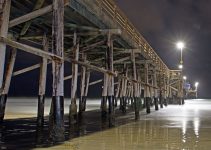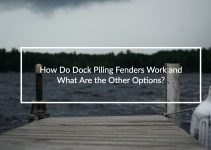A dock’s pilings are essentially its legs—its foundation. The pilings hold the dock up and steady, hopefully supporting it both initially and for many years to come.
Unfortunately, there are many things that can harm a dock’s piers and poles. Among these are marine life and organisms, weather and the elements, and other physical impact and damage. In fact, just the very fact that a dock’s posts live in the water, under the hot sun, can pose a significant risk over time.
Typically, when a dock owner thinks about protecting piers and posts from the aforementioned dangers, the options that most often come to mind are dock piling and post bumpers.
Dock bumpers — also known as dock piling or dock post bumpers — create a physical barrier between things that could hit, strike, and harm the dock’s piers and create damage.
This damage can be significant, such as is the case with “shock to dock”. Or damage can be relatively minor, but still costly since small degradations can have bigger cumulative effects as the years pass.
Dock piling bumpers can also help to protect watercraft from being hurt by the dock as well.
If you own a dock or pier you’ve probably, not-so-happily, experienced the damage that can be done when watercraft accidentally come in contact with the dock. Even a seemingly minor “touch” of the craft to the dock’s posts can create the need for costly repairs.
However, dock bumpers can help to mitigate some of this damage. First, they serve as a barrier between the watercraft and the posts, helping to prevent scrapes and scratches. Then, they also absorbing some of the impact, reducing the possibility of dings and dents.
Thus, some of the types of piling bumpers you might typically see include options that allow a watercraft to basically bounce off the dock’s posts when contact is made. Materials for dock post bumpers might include anything from rubber tires to commercially made, pre-built, dock fenders that attach securely to posts for maximum protection and durability.
Either choice described above will do a pretty good job of protecting against physical contact of watercraft to dock and vice versa. Therefore, they can seem like the perfect option for dock and pier post protection. But is that really true?
When it comes to protecting dock piers and posts from marine life and organisms, weather and weathering, and even water damage over time in general, dock bumpers aren’t really going to cut it. Furthermore, they provide little protection for swimmers that might bump up against the dock’s legs and they also provide no UV protection for piers and posts either.
Those risks to a dock’s posts shouldn’t be taken lightly either. Just like physical damage, these other “dock dangers” weaken the integrity and strength of a dock’s pilings and can weaken its structural integrity after consistent or continual exposure.
To combat these things, it becomes necessary to consider other options. Pier or piling wrap might be the answer for long-term protection of dock posts to the many risk factors they face.
Dock piling or post wrap is pretty much as it sounds—it’s a dock protection product that it comes in a flexible roll or flexible pieces that are wrapped around the dock piers and secured with stainless steel fasteners.
Piling wrap is commonly made of a flexible, long-lasting, and durable material such as HDPE plastic. This is a high-density, recycled, plastic that is super tough and durable, almost surely lasting the life of your dock.
One such dock piling wrap that not only looks good but is also extremely effective, is Pier Protector.
Pier Protector is a high-quality HDPE piling wrap product that comes in a modern and sleek black color. It’s also super easy to install and is UV-resistant. Additionally, because it completely wraps around the pole, it provides protection from marine organisms, weathering, and even some degree of impact both to and from watercraft, and for swimmers.
Furthermore, unlike most other comprehensive pier post protection options that can only be installed before the dock is put in the water, or that are extremely costly and time-intensive to put on, Pier Protector is much more flexible. It’s affordable and so long as any existing damage can be removed (marine organisms) or repaired before installation, it can be added to an existing dock. This means Pier Protector can be used both for the repair of previous damage and prevention of future damage too.



